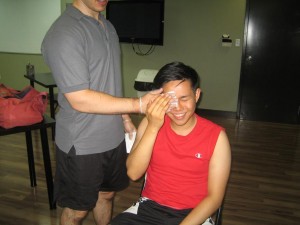A black eye is also called eye contusion. It is a condition where the soft tissues that are surrounding the eye become swollen and bruised. It can be caused by an injury to the face or head that results to the accumulation of fluid around the eye and cause discoloration and swelling. The skin that surrounds the eye is very sensitive and the blood vessels beneath can get easily injured and result to distension and bruising around the eye.
The swelling and discoloration disappears gradually in a few days, but sometimes the condition can be a sign of a more serious injury.
Causes of black eye
- A direct hit on the face by a rounded object, such as a hard ball
- Trauma or injury on the eye usually by playing contact sports such as soccer and boxing.

Swelling, pain and discoloration around the eye. - Falling to the ground facedown
- Basilar skull fracture that results to a condition called “raccoon’s eye”
- Bumping into a furniture
- Jaw surgery, facelift and nose surgery
- Medical conditions such as allergic reactions, cellulitis, dental infections.
Symptoms
- The area is tender to the touch
- Swelling, pain and discoloration around the eye
- Blurry vision
- Difficulty opening the eye/eyes
- If due to some form of head injury, headaches are present
- Loss of consciousness
- Discharge coming from the affected eye, ear or nose which can be clear or with blood
- Blood on the surface of the affected eye
- Deformity of the eyeball
- Dizziness
- Nausea and vomiting
- Behavioral changes
Treatment
- Apply a cold compress on the affected eye at least 15-20 minutes every 2 hours to lower the temperature of the area around the eye immediately after the injury for the first 24 hours. Avoid placing ice directly on the eyes and wrap using a towel or a cloth before placing on the area to prevent further damage and worsen the condition. The cold constricts the blood vessels and lessens the swelling.
- After a few days of applying an ice pack, apply warm compress to the black eye for proper flow of blood in the area and for fast healing of the condition.
- The affected person needs to lie down and the head should be elevated to lessen the bleeding. Place a couple of pillows under the head to keep it elevated.
- Take the prescribed anti-inflammatory medications such as ibuprofen or naproxen to lessen the swelling and the pain. For minor pain, take over-the-counter analgesics.
- Gently massage the area that surrounds the bruises to activate the lymphatic system for fast healing of the condition.
Tips
- Wear proper sports eye wear, safety glasses and protective head gear such as a face shield when performing hazardous activities and playing sports.
- Wear seatbelts to lessen the risk of black eye from minor vehicular accidents.
- At home, avoid leaving objects on the stairs to prevent accidentally stepping on the object and cause a fall and eye injuries.
Disclaimer / More Information
The material posted on this page on a black eye is for learning purposes only. Learn to recognize and manage this type of tissue injury by taking a first aid and CPR class with one of our training providers.
